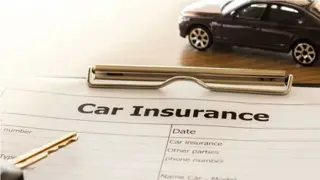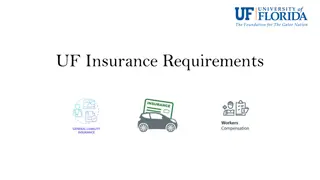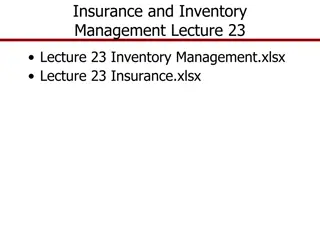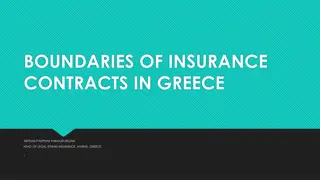Understanding Commercial Package Insurance for Small to Medium Businesses in the UK
Alan Chandler, a Chartered Insurer, provides an insightful overview of commercial package insurance, focusing on the history, coverage, and purpose of these policies for small to medium businesses in the UK. With a wealth of experience in training insurance professionals and a high pass rate in CII qualifications, Chandler equips delegates with the knowledge to guide customers on setting correct sums insured. The growing number of small businesses in the UK underscores the importance of tailored insurance solutions for various business structures.
Download Presentation

Please find below an Image/Link to download the presentation.
The content on the website is provided AS IS for your information and personal use only. It may not be sold, licensed, or shared on other websites without obtaining consent from the author. Download presentation by click this link. If you encounter any issues during the download, it is possible that the publisher has removed the file from their server.
E N D
Presentation Transcript
An Overview of Commercial Package insurance By Alan Chandler, Chartered Insurer
I have trained more than 2,000 individuals to become ACII qualified I have trained over 50% of the individuals in the last 8 years that have gone onto achieve the highest ACII pass in the whole of the UK. I train to a pass rate of more than 96% in all CII qualification levels. Certificate , Diploma and Advanced Diploma. I have delivered the Allianz scholarship and academy programmes in both the UK and Ireland and the Ask Alan facility for Zurich. Alan Chandler, Chartered Insurer Alan Chandler, Chartered Insurer e mail alanchandler@uwclub.net e mail alanchandler@uwclub.net Linkedin Linkedin Alan Chandler Alan Chandler I have delivered training throughout Europe for many major brokers and insurers. I have trained students who have won national prizes in almost all ACII subjects including Insurance Law (MO5), Liability (M96), Commercial Property and BI (M93), Personal Lines Insurance (P86), Business and Finance (M92), Underwriting Practice (M80), Advanced Underwriting (960), Claims Practice (M85), Advanced Claims (820), Marketing (945), Advanced Broking (930) and Advanced Risk Management (992).
Learning Objectives Delegates will be able to understand: The history of commercial package insurance. The cover provided by each of the main sections of a package policy. How to guide customers in setting correct sums insured under a commercial package policy.
TO BE A ONE STOP INSURANCE SOLUTION FOR SMALL to MEDIUM COMMERCIAL BUSINESSES IN THE UK The purpose of Package insurance
Small businesses can comprise. Sole Trader Partnership Limited Company
Many more small businesses starting up There were a record 5.9 million private sector businesses at the start of 2019 and they all need insurance. This is an increase of 2.4 million more than in 2000 !!!
Businesses in the UK 5.82 million businesses were small (0 to 49 employees) 35,600 businesses were medium-sized (50 to 249 employees) 7,700 businesses were large (250 or more employees)
The UK private sector business population comprised 3.5 million sole proprietorships (59% of the total), 2.0 million actively trading Limited companies (34%) 405,000 ordinary partnerships (7%) 1.1 million companies were employers, as were 239,000 sole proprietorships and 108,000 ordinary partnerships 3.3 million sole proprietorships, 910,000 companies and 296,000 ordinary partnerships did not employ anyone aside from the owner(s). Businesses in the UK
Three main reasons Major Employment trend: Many more small businesses starting up 1. Some want to be their own boss 2. Some want the perceived tax advantages 3. The main driver is in fact they have no choice because to secure the work they want they are told to become freelance
The History of Packages. To understand how packages started we have to go back to the 70 s where Insurance like many other things were different.
Key Features of Package insurance 1. Package Policies are about Consolidating Cover. 2. Packages are designed to meet the needs of the majority of Small Businesses they are not tailored made. 3. Motor Insurance is normally excluded from a Standard Package Policy. 4. The typical package policy, will always include cover for: a) Damage to business contents (including theft, money and glass). b) B I c) EL, PL and products liability.
Why do Insurers and Brokers love commercial package policies? Insurers want to put more and more onto a package basis Brokers can offer a one stop solution mostly on line.
The main Covers Note offerings vary so always check first 1. Buildings (not automatic as many do not own their building) 2. Stock and Contents 3. Loss of rent 4. Money 5. Deterioration of stock 6. Goods in transit 7. Business Interruption 8. Employers Liability 9. Public Liability 10. Products Liability
Buildings Not automatic as many policyholders do not own their building How should the Sum insured by set? Make sure they are index linked/maybe also day one to allow for inflation?
Stock and Contents All Risks cover Contents will usually cover stock and other contents ? How do we help the policyholder set the correct sum inured for contents which will usually include co?
Target Stock Insurers will impose a small inner limit here, e.g. 1,000 to ensure the policyholder declares the correct information.
Setting correct sums insured Accountants figures differ from what insurers require in respect of: 1. Buildings 2. Stock 3. Contents 4. Gross Profit (may have an automatic limit in package)
Theft Cover Standard Theft Cover is for:
Loss of Rent Rent liability to meet continuing liability to pay rent by the tenant even if premises are damaged. Cover up to 25% of contents SI for up to 2 years rental liability, some insurers provide a specific sum insured. LOR covers temporary alternative accommodation if owner, with the cover usually being based on a percentage of the Building Si (e.g.,20%).
Money. Cover is All Risks. Definition of money is what? Cover also includes: 2. Personal Accident / Assault lump Sum 10,000, weekly benefit 100 per week maximum 104 weeks.
Deterioration of Stock Loss of freezer contents following accidental change of temperature Limit often around 2,000
Goods in Transit All Risks cover Unattended vehicles must be locked, some insurers put harsher terms on Limits around 2,500
Business Interruption Cover is Gross Profit or Gross Fees what is the difference? Cover will automatically include economic ICW. Insurance Bi is different from accountants Bi.
Bi extensions Suppliers Public Utilities Damage denial of access Murder, suicide, pests, food poisoning and maybe some specified disease cover. Book debts
Employers Liability What does this cover? Cover is for 10m any one occurrence. Legally required.
Public Liability What does this cover? Limits between 2m and 5m any one occurrence. Work away may be restricted to clerical, delivery or collection work unless specifically declared.
Products Liability What does this cover? Limits of indemnity between 2m and 5m in the AGGREGATE what does this mean?
Optional extensions - a few may come automatically Buildings Legal expenses Fidelity insurance Terrorism Portable equipment away from the premises (this would not be stock) Computer Breakdown Personal accident Loss of licence non renewal or withdrawal of licence due to circumstances beyond the insured s control Cyber Liability























